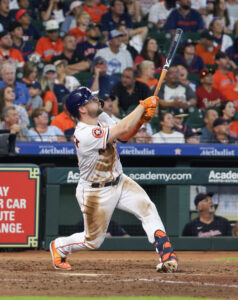While the Rangers have gone 7-0 so far through the postseason, ace right-hander Jacob deGrom has been forced to watch his club’s success from home after undergoing Tommy John surgery back in June. The long time Mets righty sat down with Joel Sherman of the New York Post recently to discuss his recovery process four months removed from the surgery.
Fortunately, it appears that deGrom’s rehab process is going rather well. A typical timeline for a pitcher in deGrom’s situation would be somewhere between 14 and 18 months before returning to a big league mound but deGrom expressed optimism that he could return to the Rangers at the earlier end of that window, with August 2024 as a stated goal. Of course, there’s a long road ahead to reach that point, though Sherman notes that deGrom has regained full range of motion at this point and will be able to return to throwing shortly after the new year, with a mound in sight come Spring Training.
If deGrom is indeed healthy and effective come the stretch run in 2024, he’d surely provide a massive boost to a Rangers club that dominated for much of the 2023 regular season and has seemingly found a second wind during the postseason in spite of a difficult stretch run that saw the club slow to a 38-33 record in the second half this season. Ignoring any possible offseason additions, deGrom would return to a 2024 rotation group that projects to feature former Mets co-ace Max Scherzer, veterans Nathan Eovaldi and Jon Gray, southpaw Andrew Heaney, and right-hander Dane Dunning. When on the mound for the Rangers this year, deGrom was nothing short of excellent with a 2.67 ERA and 1.54 FIP across six starts. His current contract runs through the end of the 2027 season, with a 2028 club option that triggered as a result of him undergoing Tommy John surgery earlier this year.
More from around the state of Texas…
- Sticking with the Rangers, manager Bruce Bochy spoke to reporters this afternoon regarding tomorrow’s Game 3 of the ALCS, where Scherzer is expected to take the mound in a competitive setting for the first time in over a month due to a teres major strain. While Bochy didn’t specify whether or not Scherzer would have any sort of limitations on him headed into tomorrow’s game, Cody Stavenhagen of The Athletic relayed that Bochy referred to 70 pitches as a “baseline” for Scherzer. That’s in line with his previously reported 68-pitch simulated game prior to the ALCS. If Scherzer is indeed limited in some capacity during tomorrow’s game, the Rangers have plenty of long relief options available to them, including Cody Bradford and Martin Perez.
- Meanwhile, Astros manager Dusty Baker spoke to reporters (including The Athletic’s Chandler Rome) this afternoon regarding the club’s plans for the remainder of the ALCS, in which they trail their division rival 0-2. Baker noted that he’s spoken to outfielder Kyle Tucker about a potential move down the batting order, though he emphasized that such a move would be temporary. It’s been a rough postseason for Tucker, as the 26-year-old has gone hitless in the ALCS so far after slashing just .143/.294/.214 in 17 trips to the plate against the Twins during the ALDS. Baker did not, however, indicate whether or not the club is considering turning to veteran ace and future Hall of Famer Justin Verlander on short rest for Game 4, saying that the club hasn’t discussed the possibility yet. Verlander would be on three days of rest for Game 4, a situation in which the Astros have used him in the playoffs before. As Rome notes, Verlander struggled against the Rays in Game 4 of the ALDS back in 2019 on three days of rest, allowing four runs in 3 2/3 innings of work.
